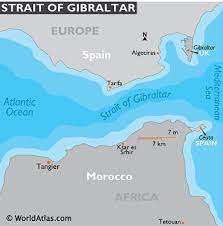
Existence of subduction zone in the Strait of Gibraltar
Existence of subduction zone in the Strait of Gibraltar
GS-1: Physical Geography
(UPSC/State PSC)
Important for Prelims:
Strait of Gibraltar, Ring of Fire, Subduction Zone, Continental and Oceanic Plates, Indian Plate, Tectonic Plates.
Important for Mains:
About subduction zone, its process and characteristics, its impacts, future implications.
27/03/2024
Why in news:
Recently, scientists have expressed the possibility of the existence of a 'Ring of Fire' subduction zone beneath the Strait of Gibraltar.
- These subduction zones, called the "Ring of Fire", contain "the most seismically and volcanically active regions in the world", responsible for more than 80% of the world's largest earthquakes and most of the planet's active volcanoes.
About Subduction Zone:
- A subduction zone is a place where a planet's two tectonic plates collide and dive, or subduct, beneath each other.
- Tectonic plates are pieces of the Earth's rigid outer crust that slowly move across the planet's surface over millions of years.
- This is the main theory of plate tectonics, the theory that parts of the Earth's crust slide over the lower mantle, carrying continents with them.
- That outer layer, known as the lithosphere, consists of the Earth's crust and the upper part of the mantle, which is a dense, hot layer beneath the crust.
- When two tectonic plates meet in a subduction zone and slide beneath each other, this lithosphere material is pulled down into the hot mantle.
- This tectonic process can generate some of the planet's most powerful earthquakes, tsunamis and volcanoes.
- This subduction process is often caused by two different types of lithosphere that make up tectonic plates: continental and oceanic.
- Since oceanic material is denser than continental lithosphere, when the two collide in a subduction zone, the oceanic part sinks beneath the more buoyant continental lithosphere.
- Subduction zones can also occur when both colliding plate segments are composed of oceanic material. In these cases, older, denser oceanic lithosphere sinks beneath younger, more buoyant oceanic lithosphere.
- A new oceanic lithosphere forms where plates move apart, bringing hot mantle material to the surface. As it moves away from those boundaries, the lithosphere becomes cooler and denser. Thus, older oceanic lithosphere may sink more easily.
- The sinking plate, or "slab", in a subduction zone is inclined at an angle of about 30 degrees to the Earth's surface, although some angles are flatter or steeper than this.
- Sometimes, subduction may begin spontaneously, without collisional forces between the plates. This happens when the lithosphere becomes unstable and sinks under the force of gravity. Oceanic lithosphere can become so old and dense that it collapses and spontaneously forms a subduction zone.
- Subduction zones are found in a horseshoe shape along the Pacific Ocean, offshore the United States, Canada, Russia, Japan and Indonesia, and along the southern coast of New Zealand and South America.
- The process of subduction is driven by the temperature difference between the subducting slab and the surrounding asthenosphere, because colder oceanic lithosphere has, on average, greater density.
- The subducting plate, or 'slab' sinks into the Earth's mantle due to the extreme weight.
Subduction Zones and Plates:
- The Earth's lithosphere is divided into two types of plates: continental and oceanic, and is divided into seven major and some minor plates.
- Oceanic plates are comparatively heavy, so when they collide with continental plates, they bend downwards, creating a subduction zone.
Major Plates:
- Antarctica and the surrounding oceanic plate;
- North American plate (along the western Atlantic floor separated from the South American plate with the Caribbean islands);
- South American plate (with the western Atlantic floor separated from the North American plate with the Caribbean islands);
- Pacific Plate;
- India-Australia-New Zealand Plate;
- Africa along the Eastern Atlantic Floor Plate;
- Eurasia and adjacent oceanic plates;
Small Plates:
- Cocos Plate: Between Central America and the Pacific Plate;
- Nazca Plate: between South America and the Pacific Plate;
- Arabian Plate: most of Saudi Arabia's landmass;
- Philippine Plate: Between the Asian and Pacific Plates;
Subduction zones and seismic activity:
- At shallow depths the interface between the plates can become 'locked' and tension can build up along these giant 'megathrust' faults.
- Eventually, the stress exceeds the strength of the fault and it breaks free, releasing the energy stored in the earthquake in the form of seismic (shaking) waves.
- The sheer size of these faults produces the largest earthquakes on Earth.
Subduction Zones and Volcanic Activity:
- As the subducting plate descends into the mantle, there is a change in pressure and temperature that causes water to escape. This water can cause the upper mantle to melt, creating magma that can rise to the surface, resulting in a volcanic eruption.
Future Implications:
- Subduction zones are not static and evolve over time.
- For example, scientists have expressed concern about the future of the Atlantic Ocean in a recent study.
- They identified a subduction zone, known as the 'Ring of Fire', that could potentially swallow the Atlantic Ocean near the Strait of Gibraltar.
- This zone is expected to expand westward in the next 20 million years.
About Strait of Gibraltar:
- The name Strait of Gibraltar comes from a rock, which is derived from the Arabic word Jabal Sarik (meaning "Mountain of Tarik").
- Gibraltar is a narrow strait that connects the Atlantic Ocean to the Mediterranean Sea and separates Europe (Spain) from Africa (Morocco).
- This strait is located in the territorial waters of Morocco, Spain and the British overseas territory of Gibraltar.
Source: Times of India
--------------------------------------
Mains Question:
Recently, scientists have expressed the possibility of a 'Ring of Fire' subduction zone beneath the Strait of Gibraltar. Discuss its implications.